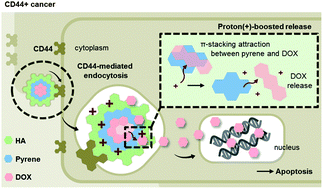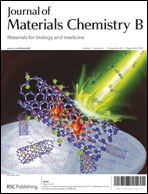π-Hyaluronan nanocarriers for CD44-targeted and pH-boosted aromatic drug delivery†
Abstract
Molecular targeted delivery of therapeutic agents and their stimuli-responsive release are some of the major issues for modern medical administration, particularly in cancer chemotherapy. In this study, we developed a π-hyaluronan nanocarrier (πHNC) for CD44-targeted and pH-boosted delivery of an aromatic anticancer drug to cancer cells. Amphiphilic π-hyaluronan (pyrenyl hyaluronan, πHA) was synthesized using EDC chemistry, and self-assembled to form πHNC, the structure of which was obviously micellar but was convincingly effective to function; (i) a π-rich pyrenyl core of πHNC, a loading aromatic drug (doxorubicin, DOX) by π-stacking attraction, showed a rapid release profile under low pH conditions which is a notable characteristic of the cancer microenvironment as well as the endolysosomal state after uptake into the target cell and (ii) the hydrophilic hyaluronan shell of πHNC acted as a ligand for CD44 resulting in the localization of πHNC into the target cell by CD44-mediated endocytosis, without cytotoxicity. With its targeted and stimulated delivery of aromatic drugs to the target cells, DOX-loaded πHNC (πHNC/DOX) provided effectual therapeutic activity in both in vitro and in vivo models of CD44-positive human gastric cancer, which is suitable as a facile and efficient drug delivery platform.


 Please wait while we load your content...
Please wait while we load your content...